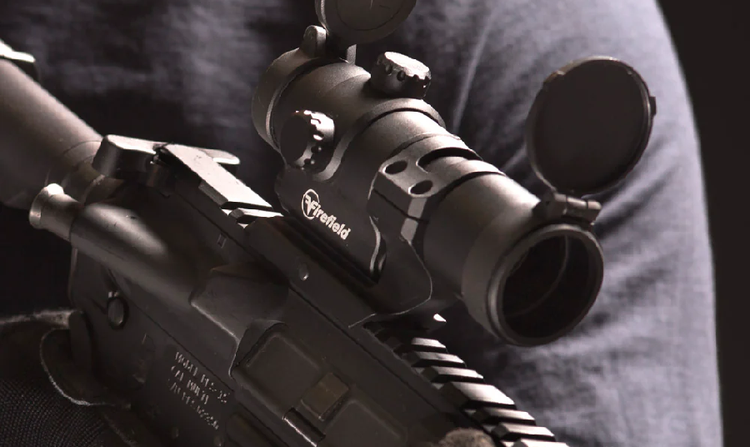So you think you want a red dot for home defense. Nice. Red dots make the job of aiming simple: you point, you see the dot, you pull the trigger. No peering through a complicated reticle, no worrying about a blurry sight picture, and you gain the ability to shoot at odd angles. If your goal is to get one useful hit fast in a messy, close-quarters fight inside a house, a red dot is the right optic for you.
In a hallway or cramped living room, speed matters more than the inch-level precision that true riflescopes provide. Red dots trade precision accuracy for speed of presentation. They let you keep both eyes open, maintain peripheral awareness, and follow moving targets without wrestling the gun into an exact hold. For most defensive shots inside a home, that trade-off wins.
Knowing Your Red Dot
Your optic’s battery life determines how long you’ll remain in a fight before transitioning to iron sights, or, failing that, firing from the hip. That’s why battery life matters more than fancy buttons. Pick a sight that stays on for thousands of hours and lets you swap batteries without tearing the mount apart. Tape a spare inside the case. Don’t trust luck or memory.
A lot of folks learn the hard way that bright dots and dark rooms don’t mix. Too dim and you lose the reticle; too bright and it blinds you. You want an optic that can handle both—enough range to stay sharp in full sun but soft indoors when your eyes are dilated. Anything less is mere decoration.
In a real-life emergency, fine motor skills vanish. You won’t find a one-MOA pinprick in the chaos. A 2–4 MOA dot lands hits where they need to go and still shows up when you’re shaking. Smaller dots are for bullseyes. Bigger dots are for defense.
Accuracy is a primary concern, but remember that sometimes, mounts fail more often than optics. The wrong footprint, sloppy torque, or cheap screws will make a good sight worthless. Match the mount to the rail, torque it right, and lock it down. If you still run irons, make sure they line up. Discovering a misfit setup while something’s kicking your door isn’t training—it’s suicide.
Platform-specific recommendations
Handgun: Use a compact 2–3 MOA red dot cut or low-profile mount. Make the dot low enough not to snag when drawing, but visible enough to index fast.
Shotgun: You don’t need fine precision. A 3–4 MOA circle or dot on the receiver gives fast tracking and adequate hit probability for CQB ranges.
Rifle: A 2 MOA dot on the upper receiver, with an optional flip-to-side magnifier for longer shots. Co-witness or offset BUIS for redundancy.
Buying the cheapest plastic sight and expecting it to behave like duty gear is bad math. So is choosing a giant dot because it “looks fast” — a reticle that swallows the target is useless. Worse: carrying no spares, never practicing with the exact light/holster/weapon combo you intend to use, or removing an optic and trusting it to return to zero by luck. Any one of those mistakes turns a helpful tool into a liability when it matters.
Fix it before you need it. Keep two fresh batteries in your kit — not tucked inside the optic, but somewhere you can grab in the dark — and replace them on a simple schedule you’ll actually follow. Run dry-fire with the exact setup you’ll carry at least once a month and get to the live range often enough to confirm what the dry work showed you. If you remove the optic, use a repeatable mount, torque to spec, and verify zero at realistic distances before trusting it again. Pick a dot size you can actually find under stress (2–4 MOA suits most shooters). Finally, plan for failure: co-witnessed irons or trained transitions to iron sights are the only acceptable backups. Learn this now, not while something’s breaking your door.
Conclusion
Red dots won’t guarantee that you become a precision marksman, but they will remove a friction point from aiming and let you build useful presentation skills faster. Pick a proven optic, mount it right, train simply and often, and keep a spare battery within reach.
Frequently Asked Questions
Are red dot sights a good choice for home defense?
Yes — for close-quarters home defense a red dot prioritizes speed and target acquisition over inch-level precision, letting you keep both eyes open and present the gun quickly in a chaotic environment.
What dot size should I choose for defensive use?
For most defensive applications a 2–4 MOA dot balances visibility under stress with acceptable hit probability; smaller dots are for precision shooting, larger dots can obscure the target.
How important is battery life and what should I do about spares?
Battery life is critical — choose a sight rated for thousands of hours, allow quick battery swaps, and keep at least two fresh spare batteries in an accessible location separate from the optic.
How do brightness settings affect performance indoors and outdoors?
Brightness matters: settable intensity is needed so the dot remains visible outdoors without blinding you in dark interiors; the optic should be usable across both bright daylight and dilated-eye conditions.
What mounting and torque practices should I follow?
Match the sight footprint to the mount, torque mounts to the manufacturer's specs, use quality screws, and prefer repeatable mounts so the optic can be removed and returned without losing zero.
Should I practice with the exact setup I plan to carry?
Absolutely — dry-fire with the exact light/holster/weapon configuration at least monthly, and confirm results with live-fire practice so you know how the system performs under realistic conditions.
What backups should I plan for if the red dot fails?
Plan for failure with co-witnessed iron sights or trained transitions to iron sights; relying on luck or assuming the optic will always work is irresponsible for defensive setups.
Do platform-specific dot sizes or setups differ?
Yes — handguns typically benefit from a compact 2–3 MOA dot and low-profile mount; shotguns work well with a 3–4 MOA dot or circle on the receiver; rifles pair nicely with a 2 MOA dot plus an optional flip-to-side magnifier and BUIS for redundancy.
Is it okay to buy the cheapest red dot available?
No — cheap sights and improper mounts become liabilities. Invest in a proven optic, avoid oversized reticles that swallow targets, and maintain backups and good mounting practices.

